August 9th, 1903 — May 1st, 1954
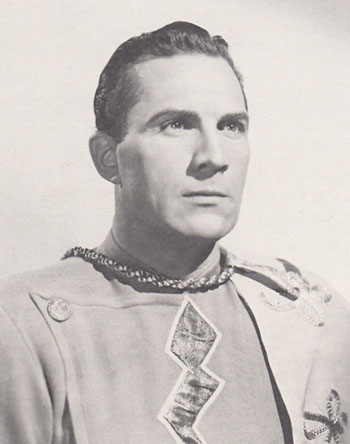
Above: Tom Tyler as Captain Marvel in The Adventures of Captain Marvel (Republic, 1941).
Tom Tyler was tall, muscular, and imposing, with a stern and somewhat grim face; he could intimidate the bad guys more convincingly than any other serial lead. However, Tyler could easily exchange an air of menace for one of joviality; in lighter moments his heroes displayed a cheerful, almost boyish enthusiasm that tempered their all-business demeanor. Tyler’s acting always had some of the uninhibited flavor of the early sound era about it, and the majority of Tyler’s work as a cliffhanger hero came in that era. In fact, he was really the sound era’s first serial “king,” starring in five different cliffhangers between 1931 and 1933. His greatest serial fame, however, came almost ten years later, when he brought his commanding physical presence and enthusiastic acting to two different costumed superhero roles.
Tyler was born Vincent Markowski in Port Henry, New York. The son of working-class Polish immigrants, he worked his way west after finishing high school, reportedly working as a coal miner, lumberjack, and boxer before finding his way to Hollywood in 1924. He began his movie career as a prop man and bit player, before being signed by FBO Pictures (later RKO) to replace their chief cowboy star Fred Thomson, who had left the studio in a salary dispute. Starting with Let’s Go Gallegher in 1925, Tom starred in many popular, generously-budgeted silent westerns for FBO and Syndicate Pictures. However, his raspy, tough-sounding voice put him at a disadvantage when the talkie era began, and as sound took firm hold of Hollywood, Tyler found himself demoted to working in B-movies, where producers cared less for vocal smoothness than for rough-and-tumble athletic ability.
Tyler’s first B-picture was his first serial, Mascot Pictures’ The Phantom of the West (1931); Nat Levine, the boss of Mascot, made a habit of hiring “name” actors who, like Tyler, could no longer capitalize on their names in bigger films. Phantom of the West was an unnecessarily mystifying but entertaining serial, and starred Tyler as a cowboy named Jim Lester, who tried to discover the identity of his father’s killer while battling a mysterious cloaked outlaw known as the “Phantom.” Unlike some of the other silent actors featured in this early-talkie effort, Tyler seemed pretty comfortable handling his (generally terse) dialogue, and manage to deliver lines that were sometimes florid or over-formal with complete sincerity and unselfconsciousness; he also looked exceptionally convincing when tossing around various minor heavies, or battling hulking henchman Joe Bonomo.
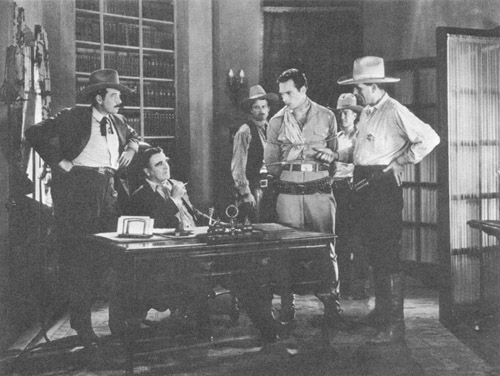
Above: William Desmond (seated) and Philo McCullough (leaning on Desmond’s chair) question the wrongfully-arrested Tom Tyler. Al Taylor (with mustache) and an unidentified player are behind Tyler, while Frank Hagney is on the far right in this scene from The Phantom of the West (Mascot, 1931).
After a few more films for Syndicate, his old studio, Tyler starred in his next serial, Universal’s 1931 release Battling With Buffalo Bill. Tyler played the famous Buffalo Bill Cody, and battled a crooked gambler (Francis Ford) who was instigating Indian attacks against the frontier town of Hard Rock in hopes of acquiring a local gold claim. Tyler had a little more dialogue here than in Phantom of the West–and occasionally stumbled over lines–but was self-assured on the whole, and definitely cut an impressive visual figure as Buffalo Bill, and satisfactorily conveyed both good-humored modesty and grim toughness. The part had originally been intended for Tim McCoy, star of two of Universal’s earliest sound serials, but McCoy had decided to leave Universal for Columbia Pictures, and Tyler thus inherited not only the Buffalo Bill role but the position of Universal’s chief serial hero.
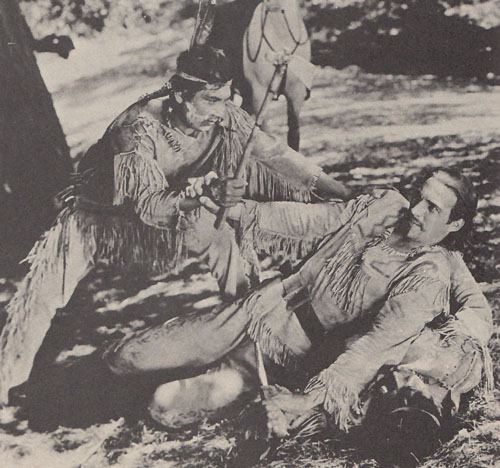
Above: Tom Tyler fights a hostile Indian in Battling with Buffalo Bill (Universal, 1931).
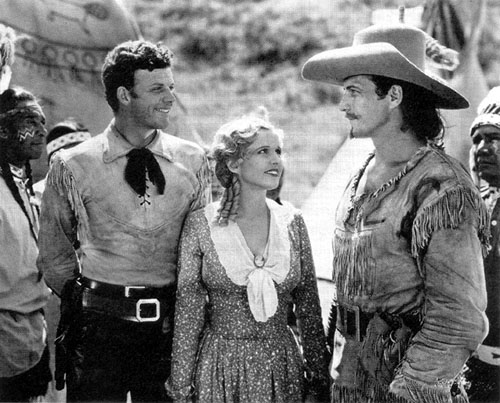 A
A
bove: Rex Bell, Lucile Browne, and Tom Tyler (along with assorted Indians) in Battling with Buffalo Bill.
Following a short string of low-budget B-westerns for Monogram Pictures, Tyler appeared in his second Universal serial, The Jungle Mystery (1932). Based on The Ivory Trail, a popular novel by Talbot Mundy, Jungle Mystery was Universal’s first really big serial success in the sound era. Tyler played Kirk Montgomery, a big-game hunter who became involved in a search for the lost ivory cache of “Tippoo Tib,” and tangled with villains led by Philo McCullough while trying to help heroine Cecilia Parker find her missing brother. Unfortunately, while Jungle Mystery was very favorably reviewed in its original release, it’s been virtually unseen since then; a print exists in the Universal archives, but has not yet become available to either serial buffs or the general public.
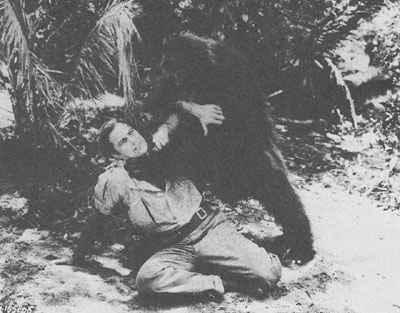
Above: A killer gorilla attacks Tom Tyler in The Jungle Mystery (Universal, 1932).
Tyler’s next Universal cliffhanger, Clancy of the Mounted (1933), starred him as Sgt. Tom Clancy of the RCMP, who was forced to arrest his brother (Earl McCarthy) for murder, and then set out to find the real culprit, soon getting involved in thwarting said culprit’s (William L. Thorne) attempts to seize heroine Jacqueline Wells’ mining property. Tyler brought an utterly believable air of straightforward sincerity and kindness to his part, particularly in his heartfelt interactions with his brother, while maintaining the properly authoritative manner of a Mountie sergeant. Clancy featured nice locations and good action, but was most notable for some genuinely dramatic and moving moments–most of which arose in large part from Tyler’s performance.
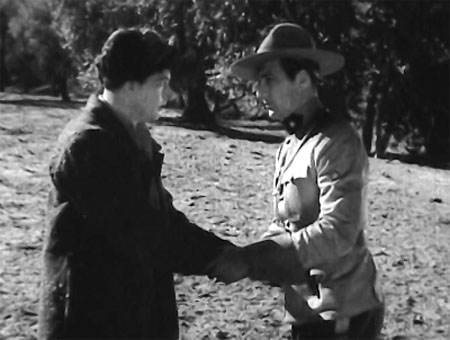
Above: Tom Tyler takes Earl McCarthy’s pledge on the family honor that he won’t try to escape in Clancy of the Mounted (Universal, 1933).
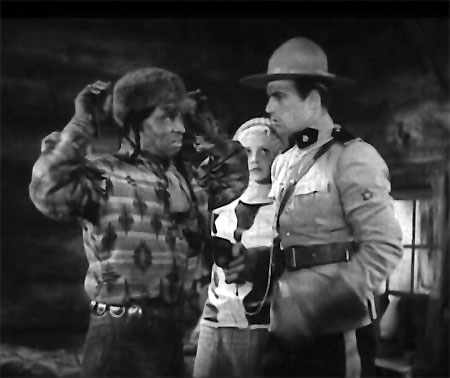
Above: Tom Tyler rescues Jacqueline Wells from renegade Indian Steve Clemente in Clancy of the Mounted.
Tyler’s last Universal serial was The Phantom of the Air (1933). Tyler played Bob Raymond, a pilot and captain in the Border Patrol who took on a gang of smugglers led by Mortimer Crome (LeRoy Mason). The Crome gang was also after an invention called the “Contragrav,” a device that powered an experimental plane called “The Phantom” and allowed it to fly without a pilot. Raymond joined with the Contragrav’s inventor (William Desmond) and his daughter (Gloria Shea) to keep the gadget out of the smugglers’ hands. Phantom of the Air was a fast-moving adventure, full of aerial action and expressing some of the sheer enthusiasm for aviation so common in the 1930s. Tyler’s simple and enthusiastic acting style suited well with his character’s daredevil deeds; when Raymond rammed his plane into an escaping villain’s craft and shrugged off the effects of the nearly fatal crash, you could really believe that his character was so unselfishly courageous as to not even realize the risk he had run.
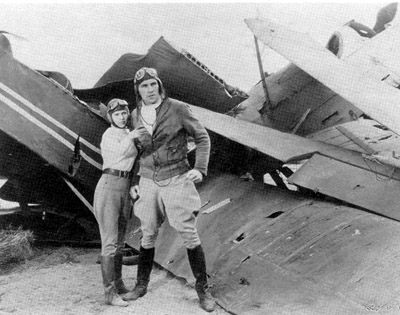
Above: Tom Tyler and Gloria Dea have just survived a crash in The Phantom of the Air (Universal, 1933).
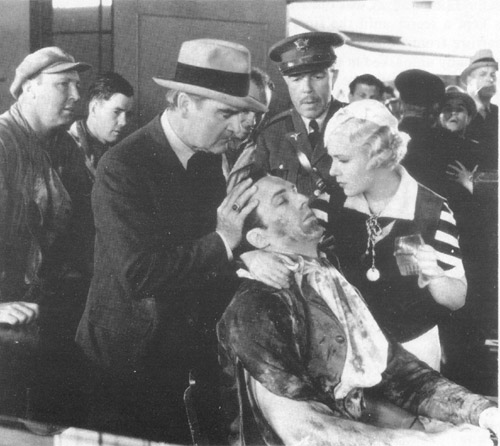
Above: After a nasty crack-up, Tom Tyler is aided by Gloria Dea and William Desmond (holding Tyler’s head) in The Phantom of the Air.
After concluding his work at Universal, Tyler starred in a long string of B-westerns for the small independent studio Reliable; this series lasted until 1936. Next, Tyler moved to Victory Productions, another independent outfit, where he starred in a series of B-westerns that ended in 1937. Tyler then joined the Wallace Bros. Circus as a rodeo performer, and was almost entirely absent from films throughout 1938. John Ford, who had directed several of Tyler’s silent Westerns, began Tyler’s comeback in 1939 by casting him in the small but memorable part of Luke Plummer, the heavy in Stagecoach. The role brought Tyler back to the attention of the major studios, and he began to work extensively as a character actor, usually playing villains. One of his most memorable parts during this time was the role of Kharis, the Mummy in Universal’s The Mummy’s Hand (1940). Tyler’s successful return to Hollywood brought him to the attention of Republic Pictures, and that studio, remembering his earlier chapterplay work, signed him to star in The Adventures of Captain Marvel (1941).
Captain Marvel would become the most famous of all Tyler’s serials. Thanks to its excellent cast, varied locations, and amazing special effects, it almost invariably heads fans’ lists of the best serials ever made. Based on Fawcett Publications’ popular comic book characters, the cliffhanger featured Frank Coghlan Jr. as youthful radio broadcaster Billy Batson, who possessed the power, given him by an ancient seer, to transform himself into the superhuman Captain Marvel (played by Tyler) by uttering the magic word “Shazam.” In the serial, this power was entrusted to Batson to help him save the world from the Scorpion, a masked master villain out to gain control of a deadly “atom-smashing” device. Tyler, who had won a weightlifting title in 1928, was able to pull off Marvel’s feats of strength quite convincingly, whether the Captain was chucking villains off roofs, lifting trees, or breaking through walls. Ironically, although Tyler took top billing in Captain Marvel, he had only a handful of lines; Coghlan’s Billy Batson handled most of the dialogue sequences, giving way to Tyler in action scenes. Despite this lack of lines, Tyler made a strong impression in each of his appearances in Captain Marvel, and it remains the serial for which he is best-remembered.

Above: Tom Tyler confronts understandably terrified henchman Carleton Young in The Adventures of Captain Marvel (Republic, 1941).
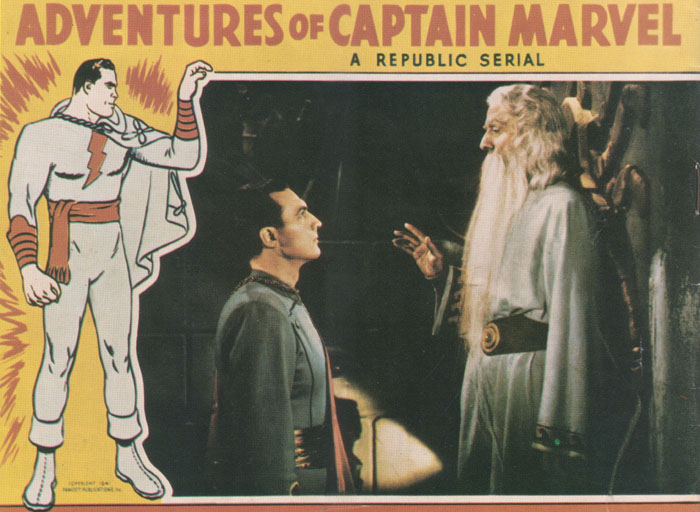
Above: Tom Tyler (left) as Captain Marvel and Nigel De Brulier as the mystic Shazam in The Adventures of Captain Marvel (Republic, 1941).
Captain Marvel proved a huge success for Republic, and they quickly re-signed Tyler after its release, casting him as Stony Brooke, one of the heroes of their long- running Three Mesquiteers B-western series; the role had previously been played by Bob Livingston and John Wayne. Tyler starred in the Mesquiteer films from 1941 till 1943, when the series ended. However, Tyler would get one more moment in the spotlight after his final turn as Stony Brooke. In 1943, Columbia Pictures cast him as Lee Falk’s comic-strip hero the Phantom in a serial of the same name.
While The Phantom was not as memorable a serial as Captain Marvel, it was one of Columbia’s best cliffhangers, and also gave Tyler perhaps the best part of his entire serial career. In the first chapter, Tyler’s character, Geoffrey Prescott, inherited a unique responsibility from his murdered father. He was called on to follow in the footsteps of the men of his line by assuming the guise of the mysterious masked Phantom, the ruler of the remote jungle tribes and the ancient foe of crime and piracy. Once he assumed the mantle of the Phantom, Tyler battled a gang of foreign agents out to establish a base in the jungle, while assisting an expedition to the lost city of Zoloz. The Phantom was the most faithful comic-strip adaptation done by any serial studio, and Tyler was absolutely perfect for the leading role. His imposing size and hawk-like profile bore a remarkable resemblance to his comic-strip counterpart, while his gruff and commanding voice suited the character’s authoritative image perfectly. He also captured the friendly, good-humored side of the Phantom shown in the comics, handling himself well in lighter scenes with leading lady Jeanne Bates and sidekicks John Bagni and Ernie Adams. Few leading men concluded their serial careers in as ideal a vehicle as Tyler did.

Above: Geoffrey Prescott (Tom Tyler, left) holds his dying father (Frederick Burton) as the old man tells him of their ancestors’ proud history in The Phantom (Columbia, 1943).
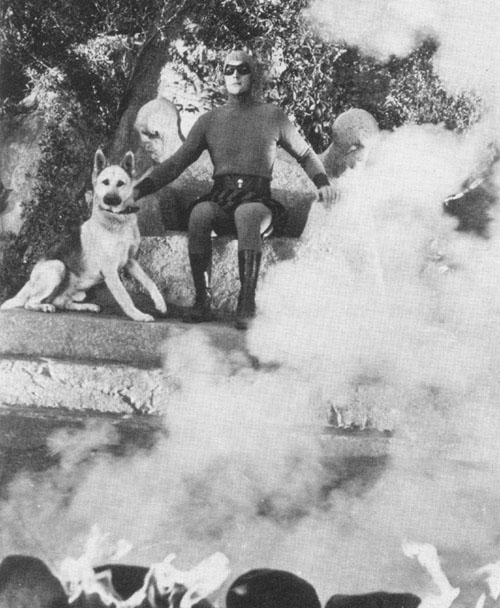
Above: Tyler, now the Phantom himself, makes a dramatic appearance before his (offscreen) assembled subjects in The Phantom. Ace the Wonder Dog, as the Phantom’s faithful friend “Devil,” is at Tyler’s feet.
Tyler made one last foray as a B-western star in Universal’s 1944 film Boss of Boomtown, in which he played co-hero to Rod Cameron. This role was a flash in the pan, however; by now Tyler was beginning to be severely afflicted by rheumatoid arthritis, and his film work began to slow down as a result. He still worked sporadically as a character actor throughout the 1940s, playing some noticeable parts in A-Westerns like Errol Flynn’s San Antonio (1945), Randolph Scott’s Badman’s Territory (1946), and Robert Mitchum’s Blood on the Moon (1948). His last really notable part was in John Ford’s She Wore a Yellow Ribbon (1949), in which he played a wounded but peppery cavalry corporal. Tyler continued to work in movies, chiefly Westerns, into the early 1950s, and also made frequent appearances on the earlier Western TV shows like The Lone Ranger and The Cisco Kid; in 1951 he made his final (and often overlooked) serial appearance, playing a bit as a Union dispatch rider in the Civil War sequence that began the Columbia cliffhanger Mysterious Island. His last film work was on The Gene Autry Show, playing henchmen in various episodes. His arthritis forced him to retire from acting in 1953, and he moved to Hamtrack, Michigan, where he had spent several years of his young manhood. He died there of a heart attack in 1954.
Tom Tyler’s characterizations in his early sound serials were reminiscent of his performances in the more theatrical silent-film era; his acting was never subtle or sophisticated, but it was always appealingly sincere. In his later serials, he used this same sincere theatricality to put across the parts of Captain Marvel and the Phantom, roles that might have come off as goofy or unbelievable in a less earnest actor’s hands. This earnestness was his hallmark throughout his long and checkered career, whether he was appearing in the films of John Ford or in the serials of Republic, Universal, and Columbia.
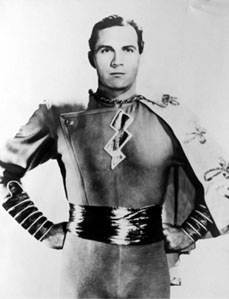
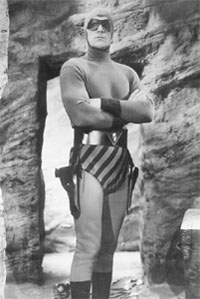
Above: Tom Tyler strikes dramatic poses in his two most famous serial roles.
Acknowledgements: My thanks to Chuck Anderson’s Old Corral website for much of the information in this article. The Old Corral’s Tyler page can be found here.
Great information! I just recently discovered Tom Tyler and am fascinated by him partly because he died at age 50, and I read he was penniless. I’m trying to find the serial “Clancy of the Mounted” of which only the first six chapters exist but not sure if anyone is selling them.
Well, thanks again,
Wayne Farrell
Hello, Thank you for all of your interest in Tom Tyler. He was my uncle. You are correct in your information. After he became ill he moved back to our house and lived with us for several years. Even though I was young my memories are vivid of him living with us. Recently I have become more interested in his super hero movies since it is a huge box office epic now with the creation of the Avengers. He was the original superhero Billy Zane also did a movie on the Phantom several years ago. Your web page is amazing. Sandra
Do you still have family in Port Henry NY ?
Love Tom Tyler and have a petition to get his surviving FBO silent films digitalized:
Turner Entertainment/Warner Brothers: Please digitalize Tom Tyler’s surviving FBO silent films
http://www.thepetitionsite.com/650/139/217/turner-entertainmentwarner-brothers-please-digitize-tom-tylers-surviving-fbo-silent-films/
Great to see so much information on Tom Tyler. Growing up a kid in the 1970s Bombay (India), I used to devour Phantom comics, and had come across a magazine article that mentioned in passing that Tom Tyler had played Phantom on the screen. Three decades later, when the internet boom allowed everybody to go back on nostalgic trips, I checked out IMDB and was perplexed to see movies titled “The Phantom of the West”, “The Phantom of the Air”, “The Phantom of the Range”, and “The Phantom Plainsmen”, none of which were really about the masked man Phantom. The one that was really about the comic book hero “The Phantom” either was not listed then or I missed it because the character was listed as Godfrey Prescott unlike in the comic books where he is “Christopher (Kit) Walker”.
Tom Tyler was (and still remains) one of my all-time favorite screen heroes. Athletic, energetic, sincere and always stalwart, he wasn’t the most polished of actors, but he conveyed an earnestness that was always appealing. His life was cut short by illness, but for those of us who loved his performances, he hasn’t been forgotten.
I agree with you, James. I’ve only recently re-discovered Tom Tyler and love him!! He was so athletic in his early days and was slated to go to the 1928 Olympics for weightlifting, but didn’t end up going. I’d love to get DVD’s of his serials. Just watching his movies, I get the impression he was a really nice man.
Thanks for another great bio! I’ve seen Captain Marvel and The Phantom, and I’m down to the last couple of chapters of Phantom of the West. You aren’t kidding when you speak of his “gruff and commanding voice”. In The Phantom, l loved every time he would interrupt some henchman in the middle of spinning a less-than-truthful version of what had occurred with “You lie!” or “THAT’S a lie!” And, by golly, he just did it in this serial, too.
And his weightlifting background explains a great Phantom of the West bar fight scene in which a thug standing atop the bar attempts to leap onto Tyler, who reaches up, grabs him in mid-leap and smoothly propels the thug onto several other thugs coming toward Tyler from the other direction.
TOM TYLER played the best serial super hero ever! It’s a shame he died broke and this is how nobody cared!!! He will be well remembered by me.
There is a Kickstarter for the restoration and digitization of two Tom Tyler silent films from 1929: “The Man from Nevada” and “Law of the Plains” which ends June 2, 2024:
https://www.kickstarter.com/projects/aventurasdetomtyler/the-tom-tyler-silent-film-collection